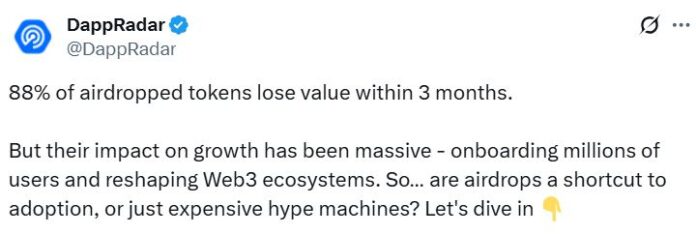The concept of airdrops has been a staple in the cryptocurrency space, with new projects frequently employing this strategy to distribute their tokens to a wide audience. However, a recent report from DappRadar analyst Sara Gherghelas reveals that up to 88% of airdropped tokens experience a decline in value within three months. This phenomenon underscores the disparity between short-term hype and long-term sustainability in the crypto market.
According to the report, which analyzed data from the past seven years, projects have distributed over $20 billion in airdrops since 2017. Despite this substantial investment, the majority of airdropped tokens struggle to maintain their value over time. Robert Hoogendoorn, Head of Content at DappRadar, attributes the success of an airdrop to the distribution strategy employed by the project. “Projects want to put their token in the hands of diamond holders,” he explained in an interview with Cointelegraph.
Hoogendoorn highlighted the importance of token distribution, citing examples of successful airdrops that utilized phased distribution, such as Optimism, or targeted distribution to limit community sell-offs. However, he emphasized that there is no single formula for success, as it ultimately depends on factors like distribution, product-market fit, and token utility. Additionally, general market trends significantly impact airdrop valuations, making it crucial for projects to maintain community interest in their product beyond the initial token deployment.
Evolution of Airdrops
The first recorded crypto airdrop occurred in 2014, when the Auroracoin project airdropped its native coin AUR as an alternative to Bitcoin in Iceland. Since then, airdrops have become more prevalent during bull markets, evolving to incorporate measures like on-chain engagement, social media campaigns, and liquidity provision. Hoogendoorn noted that projects are now using more sophisticated methods to analyze users’ on-chain activity, trading behavior, and social media reputation to avoid airdrop hunting and farming.
Airdrops are awarded in various ways, and projects are beginning to leverage reputation and social media activity to distribute tokens. For instance, some projects use engagement and reward platforms to allocate a portion of their airdrop tokens. This shift towards more targeted distribution strategies aims to prevent the sharp corrections that often follow mass distributions.
Failure of Airdropped Tokens
Jackson Denka, CEO of Azura, a DeFi platform backed by the Winklevoss twins, attributes the failure of airdropped tokens to their association with fundamentally unstable protocols that lack real adoption and revenue generation. “No amount of financial engineering, incentives, or bribery of users can change the fact that some assets are worth investing in than others,” he stated. Denka believes that airdrops, regardless of their structure, can increase in price over time if coupled with a good or growing product.
Hyperliquid’s airdrop launch in November 2024 was praised for excluding venture capitalists and encouraging community participation. Denka expects airdrops to eventually disappear as more initial coin offerings emerge, allowing investors to acquire tokens before they are released on the open market. This shift towards a more traditional IPO-like model may mark the end of the airdrop era, as investors become more discerning about the projects they support.
Liquidity and Airdrop Success
Kanny Lee, CEO of SecondSwap, a marketplace for trading locked tokens, identifies liquidity as a key issue with airdrops. According to Lee, projects often release too much liquidity too quickly, flooding the market with tokens and causing their value to decline. Successful airdrops, on the other hand, reward users for sustained activity, maintaining liquidity even after initial volatility, and utilize phased release schedules to gradually introduce supply into the market.
Lee believes that trends of rewarding users for holding tokens will become standard practice in the future. “Sustainable liquidity should be the main goal of any airdrop design. It’s not about how many wallets receive tokens, but how long those tokens remain active in the market,” he explained. By prioritizing sustainable liquidity, projects can prevent the sharp corrections that often follow mass distributions and create a more stable and engaged community.
For more information on crypto airdrops and tokenomics, visit Cointelegraph.

